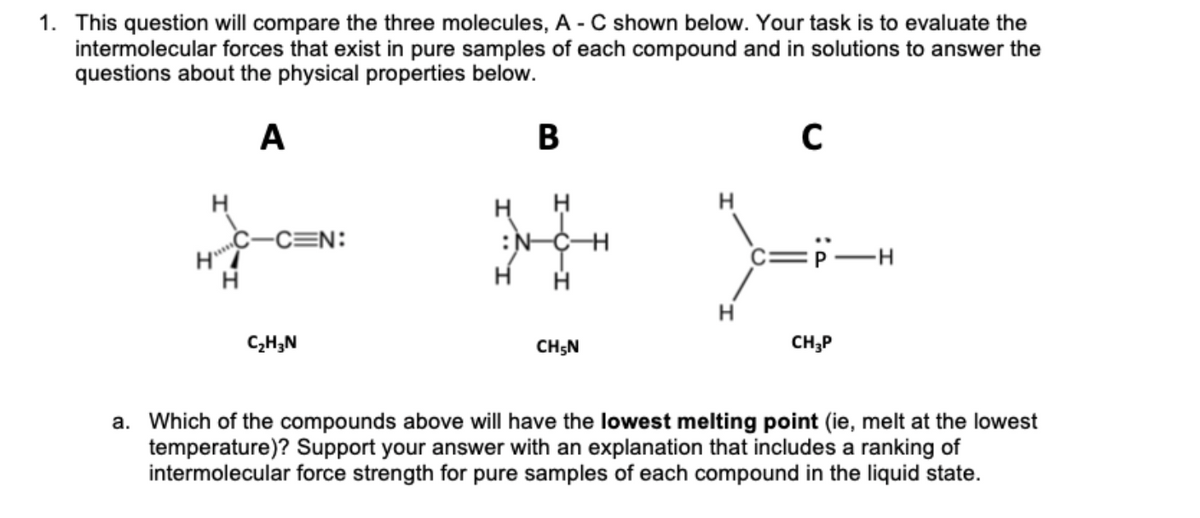1. This question will compare the three molecules, A - C shown below. Your task is to evaluate the intermolecular forces that exist in pure samples of each compound and in solutions to answer the questions about the physical properties below. A В H H HC-CEN: H :N-CH H C,H;N CH;N CH;P a. Which of the compounds above will have the lowest melting point (ie, melt at the lowest temperature)? Support your answer with an explanation that includes a ranking of intermolecular force strength for pure samples of each compound in the liquid state.
1. This question will compare the three molecules, A - C shown below. Your task is to evaluate the intermolecular forces that exist in pure samples of each compound and in solutions to answer the questions about the physical properties below. A В H H HC-CEN: H :N-CH H C,H;N CH;N CH;P a. Which of the compounds above will have the lowest melting point (ie, melt at the lowest temperature)? Support your answer with an explanation that includes a ranking of intermolecular force strength for pure samples of each compound in the liquid state.
Chemistry: An Atoms First Approach
2nd Edition
ISBN:9781305079243
Author:Steven S. Zumdahl, Susan A. Zumdahl
Publisher:Steven S. Zumdahl, Susan A. Zumdahl
Chapter9: Liquids And Solids
Section: Chapter Questions
Problem 10RQ
Related questions
Question

Transcribed Image Text:HC-C=N:
1. This question will compare the three molecules, A - C shown below. Your task is to evaluate the
intermolecular forces that exist in pure samples of each compound and in solutions to answer the
questions about the physical properties below.
A
B
H
:N-CH
c=P-H
C,H;N
CH;N
CH;P
a. Which of the compounds above will have the lowest melting point (ie, melt at the lowest
temperature)? Support your answer with an explanation that includes a ranking of
intermolecular force strength for pure samples of each compound in the liquid state.
Expert Solution
This question has been solved!
Explore an expertly crafted, step-by-step solution for a thorough understanding of key concepts.
This is a popular solution!
Trending now
This is a popular solution!
Step by step
Solved in 2 steps

Knowledge Booster
Learn more about
Need a deep-dive on the concept behind this application? Look no further. Learn more about this topic, chemistry and related others by exploring similar questions and additional content below.Recommended textbooks for you

Chemistry: An Atoms First Approach
Chemistry
ISBN:
9781305079243
Author:
Steven S. Zumdahl, Susan A. Zumdahl
Publisher:
Cengage Learning


Chemistry
Chemistry
ISBN:
9781305957404
Author:
Steven S. Zumdahl, Susan A. Zumdahl, Donald J. DeCoste
Publisher:
Cengage Learning

Chemistry: An Atoms First Approach
Chemistry
ISBN:
9781305079243
Author:
Steven S. Zumdahl, Susan A. Zumdahl
Publisher:
Cengage Learning


Chemistry
Chemistry
ISBN:
9781305957404
Author:
Steven S. Zumdahl, Susan A. Zumdahl, Donald J. DeCoste
Publisher:
Cengage Learning

Chemistry: The Molecular Science
Chemistry
ISBN:
9781285199047
Author:
John W. Moore, Conrad L. Stanitski
Publisher:
Cengage Learning

Chemistry: Principles and Reactions
Chemistry
ISBN:
9781305079373
Author:
William L. Masterton, Cecile N. Hurley
Publisher:
Cengage Learning

Chemistry by OpenStax (2015-05-04)
Chemistry
ISBN:
9781938168390
Author:
Klaus Theopold, Richard H Langley, Paul Flowers, William R. Robinson, Mark Blaser
Publisher:
OpenStax